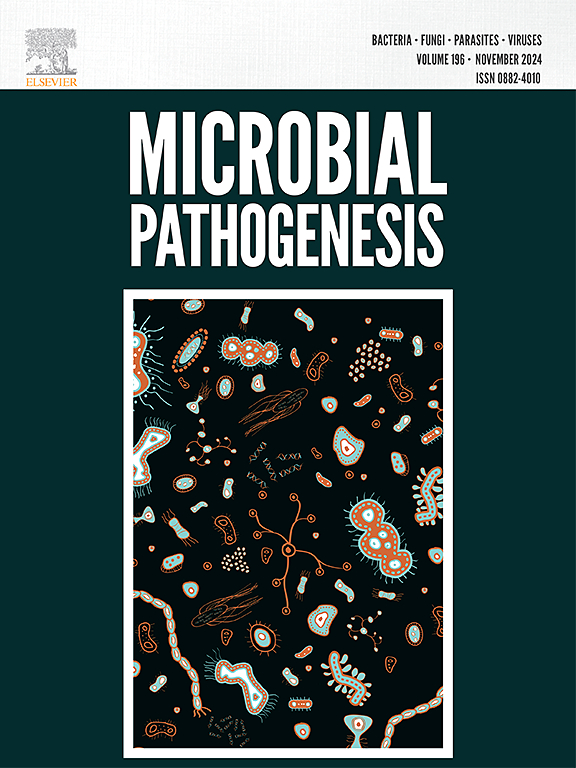基于全基因组测序的检测方法,用于研究幽门螺旋杆菌的抗生素敏感性和菌株谱系
IF 3.3
3区 医学
Q3 IMMUNOLOGY
引用次数: 0
摘要
幽门螺杆菌(Helicobacter pylori,H.pylori)的抗生素耐药性在全球范围内广泛存在且不断增加,这给成功根除幽门螺杆菌感染带来了巨大挑战。因此,识别抗生素耐药性和探索潜在的耐药性机制对于有效治疗是非常必要的。为此,我们开发了一种基于新一代测序技术(NGS)的全基因组测序(WGS)方法,检测了从中国天津患者胃黏膜中分离出的73株幽门螺杆菌的全基因组,并分析了耐药性相关基因的单核苷酸多态性(SNP)与表型敏感性之间的关联。我们发现,克拉霉素 23S rRNA 中的 A2143 C/G(Kappa:0.882)、左氧氟沙星 gyrA 中的 N87 K/I(Kappa:0.883)和阿莫西林 pbp1 的野生型基因与表型耐药性之间存在一致的关系。此外,我们还获得了 4 株超级耐药的幽门螺杆菌临床菌株,这些菌株会形成厚而粘稠的生物膜,无论抗生素靶点是否存在突变,它们都对所有抗生素具有极强的耐药性。因此,生物膜的形成也是一种耐药机制,与生物膜相关的蛋白质或基因也有望作为幽门螺杆菌耐药性的筛选标记。本文章由计算机程序翻译,如有差异,请以英文原文为准。
A whole genome sequencing-based assay to investigate antibiotic susceptibility and strain lineage of Helicobacter pylori
Helicobacter pylori (H. pylori) antibiotic resistance has been widespread and increasing worldwide, which presented a significant challenge to the successful eradication of H. pylori infection. Identification of antibiotic resistance and exploration of potential resistance mechanisms are thus necessary for effective treatment. For this purpose, we herein develop a whole genome sequencing (WGS) assay based on next-generation sequencing (NGS) to detect the entire genome of 73 H. pylori strains isolated from gastric mucosa of patients in Tianjin, China, and analyzed the association between single-nucleotide polymorphism (SNP) in resistance-related genes and phenotypic sensitivity. We discovered the consistent relationship between genotypic and phenotypic resistance by A2143 C/G in 23S rRNA for clarithromycin (Kappa: 0.882), N87 K/I in gyrA for levofloxacin (Kappa: 0.883), and wild-type of pbp1 for amoxicillin. In addition, we obtained 4 super-resistant clinical strains of H. pylori, which formed thick, sticky biofilms, were extremely resistant to all antibiotics regardless of the present of mutations in antibiotic targets sites. Therefore, biofilm formation is also a mechanism of drug resistance, and biofilm-related proteins or genes are also expected to be used as screening markers for H. pylori resistance.
求助全文
通过发布文献求助,成功后即可免费获取论文全文。
去求助
来源期刊

Microbial pathogenesis
医学-免疫学
CiteScore
7.40
自引率
2.60%
发文量
472
审稿时长
56 days
期刊介绍:
Microbial Pathogenesis publishes original contributions and reviews about the molecular and cellular mechanisms of infectious diseases. It covers microbiology, host-pathogen interaction and immunology related to infectious agents, including bacteria, fungi, viruses and protozoa. It also accepts papers in the field of clinical microbiology, with the exception of case reports.
Research Areas Include:
-Pathogenesis
-Virulence factors
-Host susceptibility or resistance
-Immune mechanisms
-Identification, cloning and sequencing of relevant genes
-Genetic studies
-Viruses, prokaryotic organisms and protozoa
-Microbiota
-Systems biology related to infectious diseases
-Targets for vaccine design (pre-clinical studies)
 求助内容:
求助内容: 应助结果提醒方式:
应助结果提醒方式:


